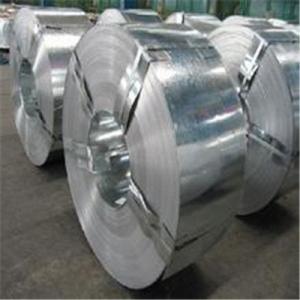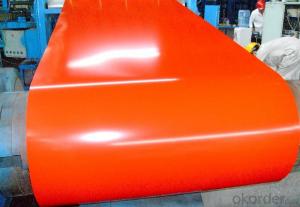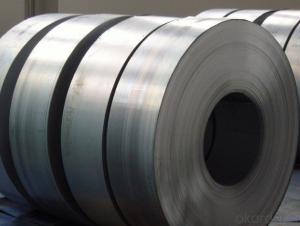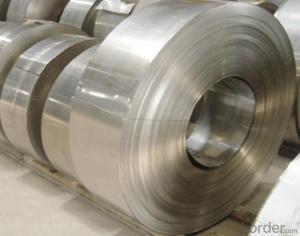Hot Rolled Steel Strip Coils Professional Manufacturer in China
- Loading Port:
- Shanghai
- Payment Terms:
- TT OR LC
- Min Order Qty:
- 33 m.t.
- Supply Capability:
- 4433222 m.t./month
OKorder Service Pledge
OKorder Financial Service
You Might Also Like
Item specifice
Applications of Steel Strip Coils:
1:Chemical industry equipment, Industrial tanks
2:Medical Instruments,Tableware, Kitchen utensil,kitchen ware
3:Architectural purpose, Milk & Food processing facilities
4:Hospital Equipment, interior Exterior decoration for building
5:Architectural purposes, escalators, kitchen ware,vehicles
Festures of Steel Strip Coils:
Standards: Q195 SGCC DX51D
Other steel grade can be provided after negotiating with customers.
Size: thickness 0.08-5mm, width 10-950mm
Packing: Seaworthy packing.
Specifications of Steel Strip Coils:
| Description | Hot Rolled Steel Strip |
| Brand | Tianjin Metallurgical No.Steel Group |
| Specification | 1.2-6.0mm*70mm |
| Standard | AISI,ASTM,BS,DIN,GB,JIS |
| Material | Q195,Q215,Q215B,Q235,Q235B |
| Application | Widly used in welding steel pipes, and bicycle making etc. |
| Certificates | BV,SGS,ISO etc. |
| MOQ | 20 tons or according to customers’ requirement. |
| Port of Delivery | Tianjin Port of China |
| Remarks | We can provide qualify goods,competitive price and speedy delivery |
Images of Steel Strip Coils:

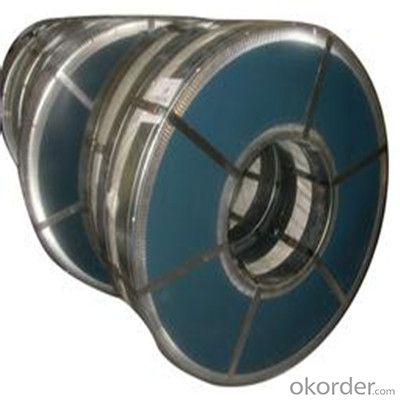
FAQ
1.What's your MOQ?
25MT, it is for one container.
2.Do you have QC teams?
Yeah, sure, our QC team is very important, they will keep the quality control for our products.
3. What's your normal delivery time?
Our delivery time about 10-20days for standard sizes, if you have other requirements like hardness and width ,it is about 20-40days.
- Q:How are steel strips processed for magnetic properties?
- Steel strips can be processed for magnetic properties through a technique called annealing. Annealing involves heating the steel strips to a specific temperature and then slowly cooling them, which helps align the magnetic domains within the material. This process enhances the magnetic properties of the steel strips, making them suitable for various applications in industries like electronics and manufacturing.
- Q:How do steel strips contribute to weight reduction in various applications?
- Steel strips contribute to weight reduction in various applications by being lightweight yet strong. They provide a high strength-to-weight ratio, allowing manufacturers to use thinner and lighter steel strips without sacrificing structural integrity or performance. This reduction in weight can lead to improved fuel efficiency in transportation, increased payload capacity in aerospace, and overall cost savings in various industries.
- Q:What is the tensile strength of galvanized steel strips?
- The tensile strength of galvanized steel strips can vary depending on the specific grade and thickness of the strips. However, typically, galvanized steel strips have a tensile strength ranging from 370 to 500 megapascals (MPa).
- Q:What are steel strips made of?
- Steel strips are typically made of carbon steel, which is an alloy of iron and carbon. The carbon content in the steel strips can vary, depending on the desired properties and end-use applications. Other elements such as manganese, silicon, and sulfur may also be added to enhance specific characteristics of the steel. The steel is typically melted and then cast into long rectangular shapes called billets. These billets are then hot-rolled through a series of rolling mills to gradually reduce their thickness and form them into long, thin strips. The resulting steel strips have excellent strength, durability, and versatility, making them suitable for various industries including automotive, construction, manufacturing, and more.
- Q:Are steel strips suitable for the manufacturing of electrical motors?
- Yes, steel strips are suitable for the manufacturing of electrical motors. Steel strips offer excellent magnetic properties and high strength, making them ideal for use in electrical motor applications. They provide efficient energy transfer and reduce energy loss, resulting in improved motor performance and efficiency. Additionally, steel strips are readily available and cost-effective, making them a popular choice in the manufacturing of electrical motors.
- Q:How are steel strips processed for surface shearing?
- Steel strips are processed for surface shearing through a series of steps to ensure a smooth and precise cutting process. First, the steel strips are cleaned to remove any dirt or debris that could interfere with the shearing process. This is typically done by using a combination of chemical cleaning agents and mechanical scrubbing. Once the strips are clean, they are then fed into a shearing machine. This machine is equipped with sharp blades that move in a vertical or horizontal motion, depending on the desired cut. The steel strips are positioned accurately, and the shearing blades are adjusted to the desired cutting length. As the shearing blades come into contact with the steel strips, they apply a significant amount of force to cut through the material. The shearing blades move along the length of the steel strips, creating a clean and precise cut. The shearing machine is often equipped with a back gauge system to ensure accurate positioning of the steel strips. After the shearing process, the cut steel strips are inspected for any imperfections or defects. Any rough edges or burrs are removed using a deburring process, which can involve grinding or sanding the edges to create a smooth finish. Finally, the processed steel strips are ready for further use or application. They may be used in various industries, such as automotive, construction, or manufacturing, depending on the specific requirements. The surface shearing process ensures that the steel strips are cut accurately and efficiently, allowing for high-quality end products.
- Q:How are steel strips used in the production of metal fences?
- Steel strips are used in the production of metal fences as they are cut and shaped to form the framework and structure of the fence. These strips provide strength, durability, and support to the overall fence design, ensuring a long-lasting and secure boundary.
- Q:What are the different methods of surface preparation for steel strips?
- Depending on the desired outcome and specific needs of the application, there are various techniques available for preparing steel strips. Some commonly used methods include: 1. Mechanical Cleaning: This method involves physically removing dirt, rust, and other contaminants from the steel strips using abrasive materials like sandpaper, wire brushes, or abrasive blasting. While effective for loose rust and paint, heavily corroded or pitted surfaces may not benefit from this approach. 2. Chemical Cleaning: Chemical solutions or solvents are used to dissolve or loosen contaminants on the steel strip's surface. Pickling, for example, entails immersing the strips in an acid solution to eliminate rust, mill scale, and oxides. Chemical cleaning is preferred for stubborn contaminants or large-scale preparation. 3. Electrolytic Cleaning: By immersing the steel strips in an electrolyte solution and passing a direct current through it, electrolytic cleaning leverages electricity to remove contaminants. This process causes the contaminants to dissolve or deposit onto an electrode, resulting in a clean surface ready for further treatment or coating. 4. Thermal Cleaning: High temperatures are employed to eliminate contaminants from the steel strips' surface. Flame cleaning or induction heating are two methods used for thermal cleaning. This approach is especially effective at removing organic contaminants and can be used alone or in combination with other techniques. 5. Coating Removal: If the steel strips are already coated with paint or other protective coatings, surface preparation may involve removing these coatings. Chemical stripping, abrasive blasting, or thermal stripping can effectively eliminate existing coatings, creating a clean and bare surface for subsequent treatment. It's important to consider factors such as the condition of the steel strips, desired level of cleanliness, and specific application requirements when selecting a surface preparation method. Each method has its own advantages and limitations, so a careful evaluation of these factors is necessary to determine the most suitable approach for a given situation.
- Q:How are steel strips used in the manufacturing of solar panels?
- Steel strips are used in the manufacturing of solar panels to provide structural support and stability, as they are strong and durable. These strips are typically used as frames or brackets to hold the various components of the solar panel in place, ensuring their proper alignment and protection.
- Q:What are the factors that affect the electrical conductivity of steel strips?
- There are various factors that can have an impact on the electrical conductivity of steel strips. 1. The composition of the steel strip plays a significant role in determining its electrical conductivity. Although steel is primarily composed of iron, it also contains other elements like carbon, manganese, silicon, and different alloying elements. These elements can affect the conductivity of the steel strip. For instance, a high carbon content can decrease conductivity, while certain alloying elements like copper or nickel can enhance conductivity. 2. The presence of impurities in the steel strip can also affect its electrical conductivity. Impurities like sulfur, phosphorus, and oxygen can introduce resistance to the flow of electrical current, thereby reducing conductivity. Therefore, it is important to minimize the level of impurities during the manufacturing process. 3. The grain size of the steel strip can influence its electrical conductivity. Smaller grain sizes generally have higher conductivity due to the increased number of grain boundaries, which facilitate the movement of electrons. Heat treatment processes can be utilized to control and optimize the grain size of the steel strip. 4. Temperature also plays a role in the electrical conductivity of steel strips. As the temperature increases, the electrical resistance of the steel also increases, resulting in a decrease in conductivity. This phenomenon is known as the temperature coefficient of resistance. It is essential to consider the operating temperature range when selecting a steel strip for electrical applications. 5. The surface condition of the steel strip can impact its electrical conductivity. Factors like surface roughness, oxide layers, and contamination can introduce resistance, leading to reduced conductivity. Proper cleaning and surface treatment methods can be employed to improve the electrical conductivity of steel strips. 6. The thickness and cross-sectional area of the steel strip can also affect its electrical conductivity. Thicker strips generally have lower conductivity due to the increased path length for electron flow. Similarly, larger cross-sectional areas allow for more efficient movement of electrons, resulting in higher conductivity. Considering these factors is crucial when designing and selecting steel strips for electrical applications, as they can significantly influence the overall performance and efficiency of electrical systems.
1. Manufacturer Overview |
|
|---|---|
| Location | |
| Year Established | |
| Annual Output Value | |
| Main Markets | |
| Company Certifications | |
2. Manufacturer Certificates |
|
|---|---|
| a) Certification Name | |
| Range | |
| Reference | |
| Validity Period | |
3. Manufacturer Capability |
|
|---|---|
| a)Trade Capacity | |
| Nearest Port | |
| Export Percentage | |
| No.of Employees in Trade Department | |
| Language Spoken: | |
| b)Factory Information | |
| Factory Size: | |
| No. of Production Lines | |
| Contract Manufacturing | |
| Product Price Range | |
Send your message to us
Hot Rolled Steel Strip Coils Professional Manufacturer in China
- Loading Port:
- Shanghai
- Payment Terms:
- TT OR LC
- Min Order Qty:
- 33 m.t.
- Supply Capability:
- 4433222 m.t./month
OKorder Service Pledge
OKorder Financial Service
Similar products
New products
Hot products
Related keywords
